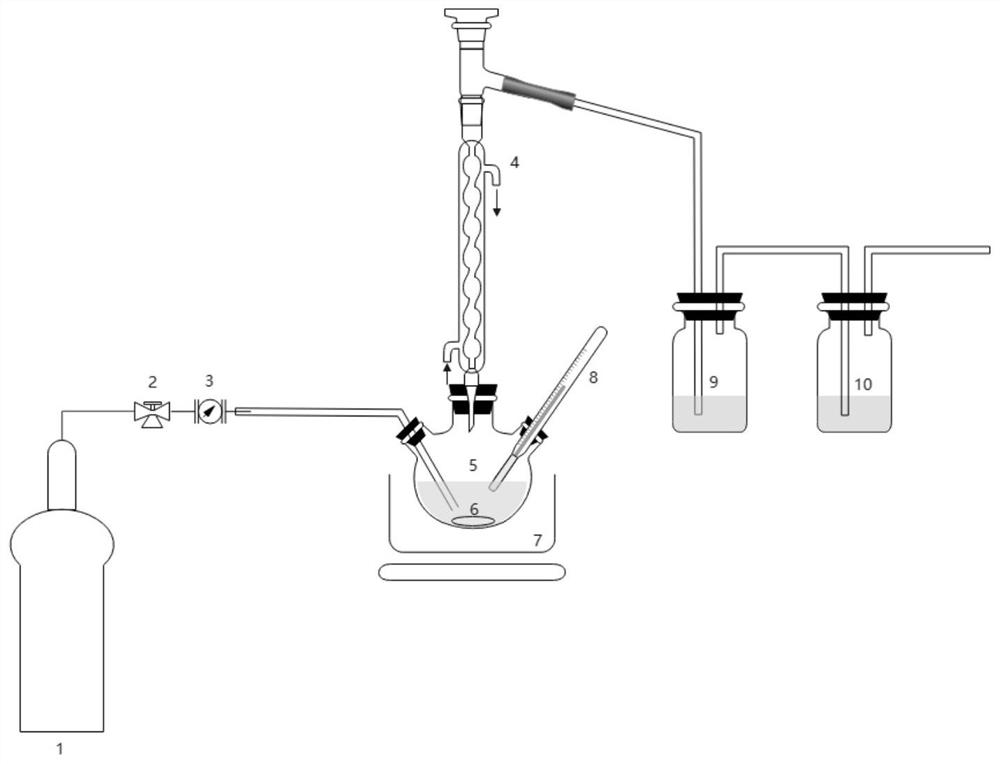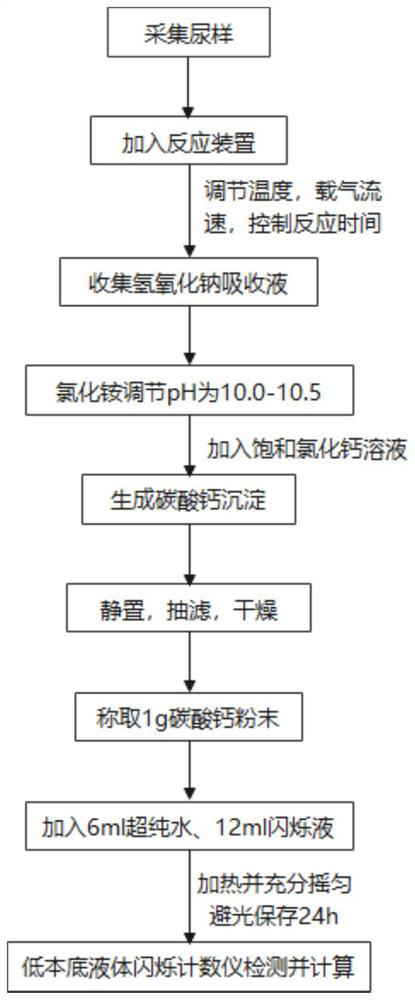Quantitative detection method for <14>C in urine
A quantitative detection method, urine technology, applied in the field of radiation health, can solve problems such as insufficient analytical methods, achieve good recovery rate and accuracy, and remove interference
- Summary
- Abstract
- Description
- Claims
- Application Information
AI Technical Summary
Problems solved by technology
Method used
Image
Examples
Embodiment 1
[0043] The present invention will be described in further detail below in conjunction with accompanying drawing and specific embodiment, embodiment 1: adopt urea carrier to optimize
[0044] (1) Weigh 0.7g, 0.9g, 1.1g, 1.3g, 1.5g of urea in turn, add 50mL of water to obtain the tested sample;
[0045](2) Put the sample into a three-necked flask, add 10g of potassium persulfate, connect the condensing device, feed nitrogen, control the gas flow rate to 0.5L / min, and connect two gas outlets with 50mL 1mol / L sodium hydroxide absorption liquid;
[0046] (3) Adjust the temperature to 95±3°C, turn on the magnetic stirring, start timing when the temperature rises to 95°C, and the reaction time is 60 minutes;
[0047] (4) After the reaction is over, transfer the absorption solution to a beaker, and adjust the pH to 10.0-10.5 with ammonium chloride;
[0048] (5) Add saturated calcium chloride solution to form a precipitate, and let it stand until the supernatant is clarified;
[0049...
Embodiment 2
[0054] Embodiment 2: reaction time optimization
[0055] (1) Take several portions of 0.7g urea, add 50mL water, and obtain the tested sample;
[0056] (2) Put the sample into a three-necked flask, add 10g of potassium persulfate, connect the condensing device, feed nitrogen, control the nitrogen flow rate to 0.5L / min, and connect two gas outlets with 50 ml of 1mol / L sodium hydroxide absorption solution ;
[0057] (3) Set the temperature to 95±3°C, turn on the magnetic stirring, start timing when the temperature rises to 95°C, and the reaction time is 90min, 80min, 70min, 60min, 50min, 40min, 30min, 20min;
[0058] (4) After the reaction is over, transfer the absorption solution to a beaker, and adjust the pH to 10.0-10.5 with ammonium chloride;
[0059] (5) Add saturated calcium chloride solution to form a precipitate, and let it stand until the supernatant is clarified;
[0060] (6) Suction filter the precipitate, and add ethanol solution to make the precipitate dry quick...
Embodiment 3
[0065] Embodiment 3: Urine sample determination
[0066] (1) Take 120mL urine sample to obtain the tested sample;
[0067] (2) Put the sample into a three-necked flask, add 10g of potassium persulfate, connect the condensing device, feed nitrogen, control the nitrogen flow rate to 0.5L / min, and connect two gas outlets with 50 mL of 1mol / L sodium hydroxide absorption solution ;
[0068] (3) Adjust the temperature to 95±3°C, turn on the magnetic stirring, start timing when the temperature rises to 95°C, and the reaction time is 60 minutes;
[0069] (4) After the reaction is over, transfer the absorption solution to a beaker, and adjust the pH to 10.0-10.5 with ammonium chloride;
[0070] (5) Add saturated calcium chloride solution to form a precipitate, and let it stand until the supernatant is clarified;
[0071] (6) Suction filter the precipitate, and add ethanol solution to make the precipitate dry quickly, and then put it into an oven for drying;
[0072] (7) After dryin...
PUM
| Property | Measurement | Unit |
|---|---|---|
| length | aaaaa | aaaaa |
| diameter | aaaaa | aaaaa |
| length | aaaaa | aaaaa |
Abstract
Description
Claims
Application Information
 Login to View More
Login to View More - R&D
- Intellectual Property
- Life Sciences
- Materials
- Tech Scout
- Unparalleled Data Quality
- Higher Quality Content
- 60% Fewer Hallucinations
Browse by: Latest US Patents, China's latest patents, Technical Efficacy Thesaurus, Application Domain, Technology Topic, Popular Technical Reports.
© 2025 PatSnap. All rights reserved.Legal|Privacy policy|Modern Slavery Act Transparency Statement|Sitemap|About US| Contact US: help@patsnap.com



